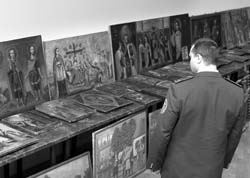Icons to stay with us

On Nov. 23, the Security Service of Ukraine (SBU) and the State Customs Service of Ukraine handed over to the national museum, library, and archive funds a unique collection of Ukrainian icons, paintings, rarities, and other antiquities from the 16th-20th centuries that Elisabeth Perleau, attache at the Belgian embassy in Kyiv, attempted to smuggle out of Ukraine. Customs officers say that the case was kept under wraps until now simply because the investigation was underway.
In 2003, after completing her term of office and using her diplomatic immunity, Perleau decided to take the unique collection abroad with her. However, according to Anatoliy Makarenko, head of the Kyiv Regional Customs Station, on July 7, 2003, during the course of police work to combat contraband, officers of the SBU’s Chief Directorate against Corruption and Organized Crime, learned that a female diplomat at the Belgian embassy was seeking to leave with a container of personal effects, including cultural and historical treasures belonging to Ukraine. Officers of the Kyiv Regional Customs Station inspected the suspect’s luggage and impounded 337 items described as antiquities: icons and folk paintings from the 18th-20th centuries, household utensils (porcelain, publications) from the turn of the 20th century, as well as a collection dating from the period of so-called socialist realism in the USSR. Among the impounded articles are unique items, such as an ancient parchment book published in the 16th century, the original first issue of the newspaper Iskra (1900; currently evaluated at 42,660 hryvnias), a 16th-century psalm book (approximately $100,000), and a number of other unique archival documents. Thus far, experts estimate the value of the collection at several million US dollars.
In 2003 the investigations department of the Kyiv Regional SBU Directorate launched a criminal case. However, according to Volodymyr Tymoshenko, first deputy chief of the SBU, an individual with diplomatic immunity cannot be prosecuted. The Holosiyevo District Court ruled to confiscate the cultural valuables and transfer them to the public domain. Paperwork and legal procedures involved in the criminal case, in which all the impounded items figured as evidence, lasted almost three years. Today, considering the significant historical and cultural value of the impounded articles, a decision was made to transfer them to the museum, library, and archival funds. Experts believe that the collection of icons and folk paintings is the most valuable part of the confiscated items, as no museum in Ukraine has such a collection.






